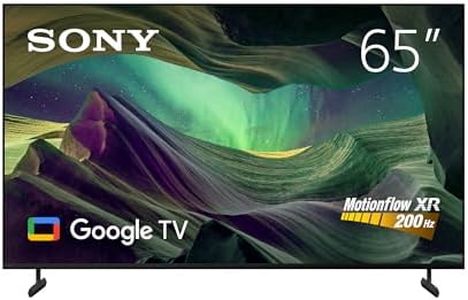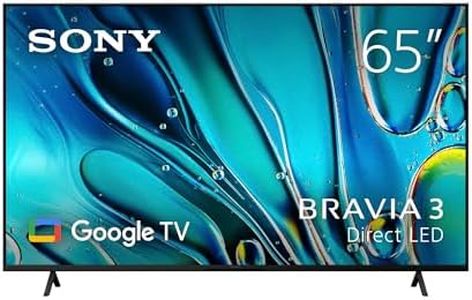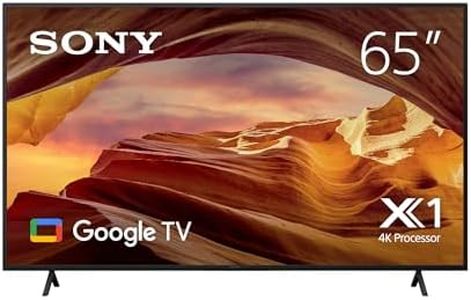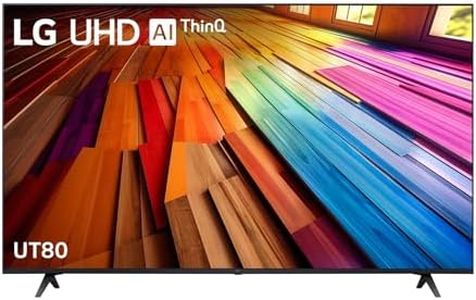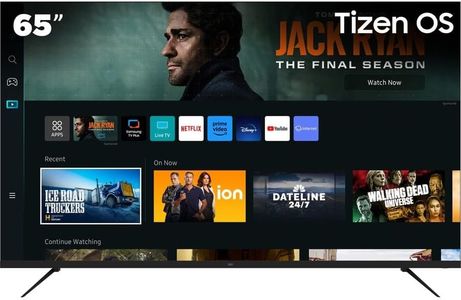We Use CookiesWe use cookies to enhance the security, performance,
functionality and for analytical and promotional activities. By continuing to browse this site you
are agreeing to our privacy policy
8 Best 65 Inch Smart Tvs
From leading brands and best sellers available on the web.Buying Guide for the Best 65 Inch Smart Tvs
Choosing a 65-inch smart TV is a great way to elevate your home viewing experience, providing a cinema-like feel in your living room. To find the best fit, you’ll want to look closely at several key specifications that determine picture quality, ease of use, and compatibility with your entertainment habits. Understanding these specs will help you match a TV to the space available in your home and the kind of content you love to watch.Display ResolutionDisplay resolution refers to the number of pixels on the screen and has a big impact on picture clarity. The most common resolutions today are Full HD (1920x1080), 4K (3840x2160), and 8K (7680x4320). Full HD is mostly found on smaller or older models, while 4K is the standard for most new 65-inch TVs. 8K offers more detail, but the difference is less noticeable unless you sit very close. For most people, a 4K resolution strikes a great balance between sharp images and content availability. Choose higher resolutions if you plan to watch a lot of high-quality content or want future-proofing.
Panel TypeThe panel type affects picture quality, colors, and viewing angles. The most common types are LED, QLED, and OLED. LED panels use backlighting and offer good brightness and efficiency. QLED panels use quantum dot technology to improve color and brightness, while OLED panels provide deep blacks and superb contrast because each pixel lights up independently. If you watch TV mainly in a bright room, LED or QLED might suit you better due to their higher brightness. If you're after the best movie experience, especially in dim environments, OLED can offer richer visuals. Think about your room lighting and what kind of content you enjoy to help decide.
Refresh RateThe refresh rate tells you how many times the screen updates per second, usually given in Hertz (Hz). Common rates are 60Hz and 120Hz. A higher refresh rate (like 120Hz) provides smoother motion, especially important for fast-action scenes or gaming. If you mostly watch movies and standard TV shows, 60Hz will be sufficient. If you're a sports fan or enjoy gaming, a higher refresh rate can deliver a smoother experience.
Smart TV PlatformThe smart TV platform is the operating system running on your TV and determines what apps and features you have access to. Popular platforms include Android TV, WebOS, Tizen, and Roku. Some have more apps, while others focus on simplicity or voice assistant integration. If you rely heavily on streaming services, choose a platform known for a wide app selection and frequent updates. Try to picture how you like to navigate menus and search for shows—ease of use matters here.
HDR SupportHDR (High Dynamic Range) is a feature that increases contrast and allows for more vivid colors, making images look more realistic. Not all HDR is the same—look for support for common formats like HDR10, Dolby Vision, or HLG. The more formats supported, the better, since different movies and shows might use different ones. If you want a more lifelike picture, pick a TV with strong HDR capabilities, especially if you plan to watch content in HDR.
ConnectivityConnectivity refers to the types and amount of ports and wireless options available, such as HDMI, USB, Bluetooth, and Wi-Fi. More HDMI ports make it easier to connect devices like gaming consoles or streaming boxes. USB ports are useful for playing media or updating firmware. Wi-Fi and Bluetooth enable wireless streaming and connecting headphones or soundbars. Think about what you'll want to hook up—if you have multiple devices, make sure your TV has enough connections for easy switching.
Audio FeaturesAudio features include the quality and type of built-in speakers, as well as support for advanced sound technologies like Dolby Atmos or DTS:X. While most built-in TV speakers are adequate for casual viewing, they can lack depth or richness for movies or music. If audio quality is important to you and you don't plan to buy a soundbar or speaker system, look for TVs with enhanced audio capabilities. Otherwise, consider the TV’s compatibility with external sound setups.
Design and BuildThe design of the TV includes its bezels, thickness, and stand style. A slim design with thin bezels looks more modern and can make the TV blend in or stand out as a centerpiece, depending on your preference. Wall-mount compatibility is also an important consideration if you want to save space or achieve a certain look. Consider your living room's layout and how the TV will fit in—will it sit on furniture or should it be mounted?
